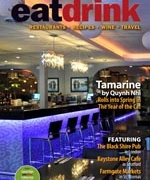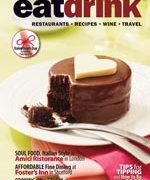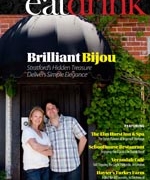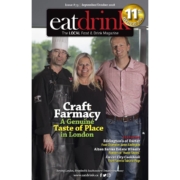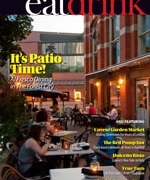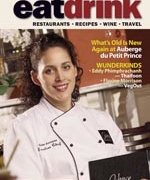The X-Files for Foodies – the Lost WPA Files for America Eats
Nearly anything can become more interesting and have a certain sense of allure when found after a time of being lost. Especially when hidden away from public eyes for some reason, as if concealing secrets, like the X-files have done with the government’s involvement in U.F.O. cover-ups. A book by Mark Kurlansky, The Food of a Younger Land, may not have quite the same extra-terrestrial flavour, but the WPA files shed light on flavours of a different sort – the scrumptiousness of regional American cooking.
The WPA files were not surreptitiously and underhandedly concealed, they simply got lost in the shuffle of history. Until, that is, Kurlansky uncovered them in the U.S. Library of Congress and found himself in the middle of a writing project similar to an archaeological adventure, culling through a 70-year-old mountain of documentation to compile a diverse collection of curiosities and recipes in food history. What Kurlansky finds in these unfinished and unedited raw texts is “a chaotic and energetic assortment of reports, stories, and poems on America and its food by hundreds of different voices, including a few who became prominent writers.” These writers were reporting from the field about what real people were eating and what local events centred around the consumption of food. Kurlansky does his part by adding to this collection of voices with his own editorial comments while he cobbles together pieces of what could have been a comprehensive work of art about culinary culture and food folklore.
The WPA itself – the Works Progress Administration – was initiated under the presidency of Franklin Delano Roosevelt and given the responsibility of creating work relief projects for unemployed Americans in the 1930s during the Great Depression. One such project was giving out-of-work writers the task of documenting the eating habits of the American people. The project was called “America Eats” and, after being abandoned in 1941 when Pearl Harbour was attacked, drifted into obscurity until Kurlansky brought this historical food treasure back to life. Kurlansky writes: “What people eat is not well documented. Food writers prefer to focus on fashionable, expensive restaurants whose creative dishes reflect little of what most people are eating. We know everything about Paris restaurants but nothing about what Parisians eat. We know little about what Americans eat and less about what they ate.” This writing project set out to change that with culinary anecdotes and regional recipes of a bygone era by well-known writers such as Nelson Algren, Eudora Welty, and Zora Neale Hurston, along with numerous “beginning writers with promise” who could write well enough to add to the “America Eats” legacy.
Like the X-files, controversy and criticism surrounded the work of the WPA, especially with the notion of funded work for artists. “The idea was received by the public with predictable cynicism. Subsidized art has never been popular with Americans. Subsidizing anything in America comes under attack. The workers of the WPA were called ‘shovel leaners.’ Now the workers of the Federal Writers’ Project were labelled ‘pencil leaners.’ Editorials argued that poverty and adversity, not government subsidies, produced great writing.” But all the writing by the “America Eats” authors was eloquent and well-crafted to prove that these unpublished pieces were from the pens of commissioned writers, some who have gone on to international fame such as Pulitzer Prize-winning authors Eudora Welty and Donald McCormick. William Lyndsay White’s description of Midwest barbeque is brilliantly written. Henry Manchester writes about Rhode Island Jonny cakes by saying, “It should be stressed that Jonny cakes must be piping hot to be enjoyed. The distance between stove and table should not be great so as to insure this condition, and though grace be omitted before eating Rhode Island Jonny cakes, there’ll surely be an added note of thankfulness in the prayer when rendered after the repast.”
The book successfully makes the case that specialty items eaten at certain periods of time in different regions throughout the U.S.A. formed the character of those regions, especially during the trying times of the Great Depression. Low quality chain restaurant fare and mass quantity frozen dinners were not part of this character-building food. It is a great lesson in history to learn how regional cooking is attuned to ingredients highlighted in certain parts of America. Each region or state has a strong sense of its own identity through food and will insist certain recipes originated there, like the mint julep in Kentucky, Jonny cakes in Rhode Island, hush puppies in Florida, and clam chowder in New England. “An Alabama eggnog is one that caresses the palate with velvety gentleness, and then once it is within the stomach, suddenly becomes the counterpart of a kicking mule.” These drinks were enjoyed at eggnog parties that “Alabamians claimed then, and still do, that no eggnog parties approached their own in lavishness and hospitality.” Cooking centres around good regional ingredients, but taste can also be subliminally effected by the way something is made. Certain corn breads in Virginia are best when the loaf “shows the imprint of the cook’s fingers that moulded it into the proper elongated shapes.”
The pieces of literature Kurlansky presents are a time capsule of food journalism and recipes, looking back at the types of food the average American was eating and the social gatherings they were having that featured food: potluck church picnics in Iowa; wild game suppers in Maine; Coca-Cola parties in Georgia; clam bakes in Rhode Island; menudo (the entire tripe of a cow) parties in Arizona; backwoods barbecues in South Carolina; maple syrup tapping in Vermont; chuck wagon mealtimes in Texas. All of these events are relived in this book and could very well act as a guide even in modern times for finding culinary gems as a traveller across the United States. The history lesson includes the spectrum of American peoples, from North American Indians to African American slaves to Jewish, Italian, and Mexican immigrants.
Many regional dishes have left a lasting imprint in the culinary lexicon of cookbooks and menus like the apple/celery/nut concoction of Waldorf Salad first served at the Waldorf-Astoria hotel in New York. Some recipes may seem dated, but really if the ingredients are still available to make squirrel stew in Arkansas or rattlesnake snacks in Florida, it becomes more a matter of personal taste than antiquation. There are other reasons for eating certain foods for something other than taste and nutrition, as beans were eaten for religious reasons in New England homes because they could be prepared a day in advance to prevent working in the kitchen on the Sabbath. Some of the entries (and entrees) in the book sound antiquated to our modern palates but allow us to step back in time with uncommon ingredients, that were once mainstay menu items in daily American lives, that you don’t come across in your average cookbook these days. The recipes are varied and wild such as Sweet Pumpkin Pickles from Vermont, Fried Beaver Tails served in Montana, Sour Dough Pancakes in Wisconsin, Persimmon Pudding in Indiana, and a questionable dish called Son of a Bitch in Kansas. Some of the descriptions resemble modern day tastes, such as the allure of real Southern barbeque.
Aside from the recipes, there are innumerable interesting anecdotes. The historical placement in Time Square in 1912 of the first coin-operated (first a nickel, and later a dime) Automat – the forerunner of fast food and precursor of the modern vending machines – that dispensed food items like chicken pie, baked beans, corned beef hash, and cinnamon buns. It was known as “the mechanical lunchroom” where “the man-in-a-hurry is worried by no middle-men; his relationship with his fodder, over which he may gloat, ruminate, or despair, is strictly private. He selects, pays, conveys, eats, and departs, leaving no tip, uttering no sound.” The last Automat closed in 1991, many of them replaced along the way with Burger King restaurants owned by the same company to the dismay of those who prefer their meals strictly private.
We are introduced to the Pop Corn Days of North Loup, Nebraska which celebrate the puffy snack food, complete with a Pop Corn Queen and free popcorn for everyone. In 1940, the North Loup population of 567 consumed 1,400 pounds of popcorn in the three-day event. Other amusing sections of the book include a lesson in luncheonette slang from the institution of the New York diner, where we learn that a “Bottle o’ Red” refers to ketchup and “Jack Benny in the Red” is strawberry Jell-O. An order for “Bull’s Eyes” will get you two fried eggs and “Two Cackles in Oink” are ham and eggs.
Some of the anecdotes are very interesting and well written, some of the recipes seem worth trying, but the book’s virtue lies in Kurlansky’s effort to assemble the collection of writing. Even though the book is essentially about food, the political side of the story is just as important – it was through Roosevelt’s vision to provide work for the writers to stimulate the economy that we are given this snapshot of American cookery. We are fortunate that Kurlansky took it to the next step to ensure the better parts of this raw research in the field of common American life does not go unnoticed. It’s good to be reminded about the virtues of a time, before the internet and the Food Network, when home cooking recipes were passed down by simple cookbooks or word of mouth.


